Howard Schultz: The Entrepreneurial Journey of Starbucks' Executive Chairman
VerifiedAdded on 2023/06/14
|15
|4276
|229
AI Summary
This article explores the entrepreneurial journey of Howard Schultz, the Executive Chairman of Starbucks. It discusses his personal context, original ideas, collaboration, and how he learned from customers and early prototyping. It also evaluates the value of the systemic and social change of the product or service. The article includes subject matter related to entrepreneurship, business, and sustainability.
Contribute Materials
Your contribution can guide someone’s learning journey. Share your
documents today.
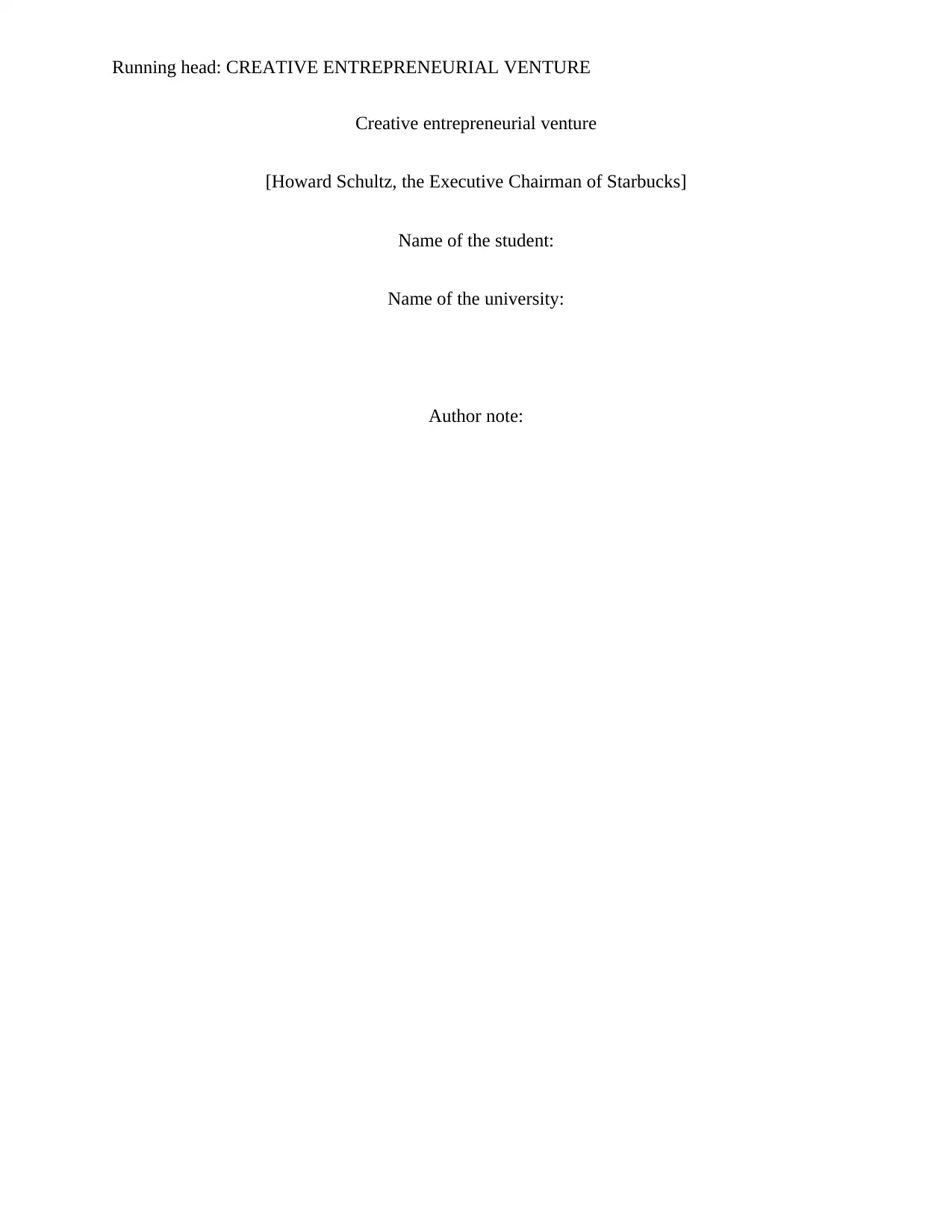
Running head: CREATIVE ENTREPRENEURIAL VENTURE
Creative entrepreneurial venture
[Howard Schultz, the Executive Chairman of Starbucks]
Name of the student:
Name of the university:
Author note:
Creative entrepreneurial venture
[Howard Schultz, the Executive Chairman of Starbucks]
Name of the student:
Name of the university:
Author note:
Secure Best Marks with AI Grader
Need help grading? Try our AI Grader for instant feedback on your assignments.
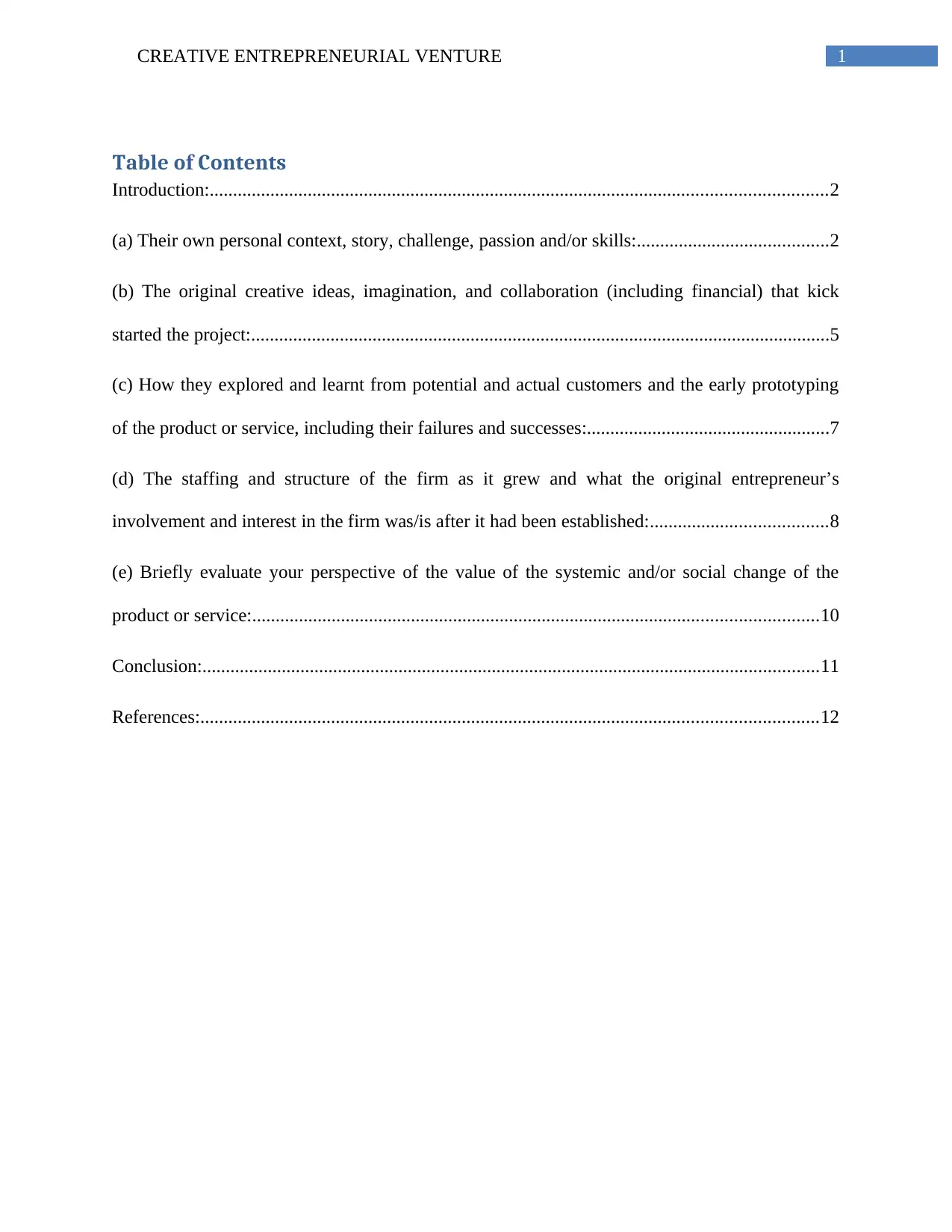
1CREATIVE ENTREPRENEURIAL VENTURE
Table of Contents
Introduction:....................................................................................................................................2
(a) Their own personal context, story, challenge, passion and/or skills:.........................................2
(b) The original creative ideas, imagination, and collaboration (including financial) that kick
started the project:............................................................................................................................5
(c) How they explored and learnt from potential and actual customers and the early prototyping
of the product or service, including their failures and successes:....................................................7
(d) The staffing and structure of the firm as it grew and what the original entrepreneur’s
involvement and interest in the firm was/is after it had been established:......................................8
(e) Briefly evaluate your perspective of the value of the systemic and/or social change of the
product or service:.........................................................................................................................10
Conclusion:....................................................................................................................................11
References:....................................................................................................................................12
Table of Contents
Introduction:....................................................................................................................................2
(a) Their own personal context, story, challenge, passion and/or skills:.........................................2
(b) The original creative ideas, imagination, and collaboration (including financial) that kick
started the project:............................................................................................................................5
(c) How they explored and learnt from potential and actual customers and the early prototyping
of the product or service, including their failures and successes:....................................................7
(d) The staffing and structure of the firm as it grew and what the original entrepreneur’s
involvement and interest in the firm was/is after it had been established:......................................8
(e) Briefly evaluate your perspective of the value of the systemic and/or social change of the
product or service:.........................................................................................................................10
Conclusion:....................................................................................................................................11
References:....................................................................................................................................12
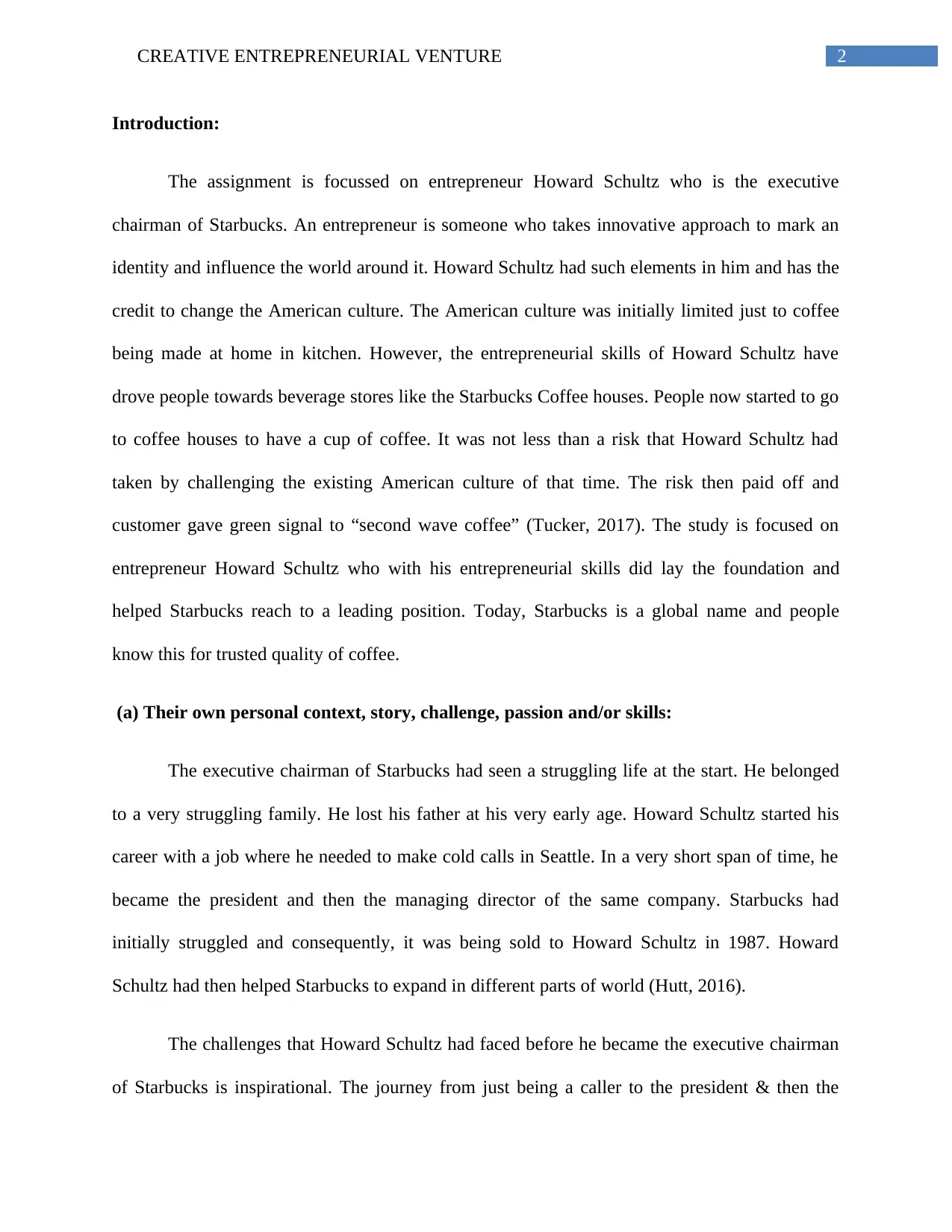
2CREATIVE ENTREPRENEURIAL VENTURE
Introduction:
The assignment is focussed on entrepreneur Howard Schultz who is the executive
chairman of Starbucks. An entrepreneur is someone who takes innovative approach to mark an
identity and influence the world around it. Howard Schultz had such elements in him and has the
credit to change the American culture. The American culture was initially limited just to coffee
being made at home in kitchen. However, the entrepreneurial skills of Howard Schultz have
drove people towards beverage stores like the Starbucks Coffee houses. People now started to go
to coffee houses to have a cup of coffee. It was not less than a risk that Howard Schultz had
taken by challenging the existing American culture of that time. The risk then paid off and
customer gave green signal to “second wave coffee” (Tucker, 2017). The study is focused on
entrepreneur Howard Schultz who with his entrepreneurial skills did lay the foundation and
helped Starbucks reach to a leading position. Today, Starbucks is a global name and people
know this for trusted quality of coffee.
(a) Their own personal context, story, challenge, passion and/or skills:
The executive chairman of Starbucks had seen a struggling life at the start. He belonged
to a very struggling family. He lost his father at his very early age. Howard Schultz started his
career with a job where he needed to make cold calls in Seattle. In a very short span of time, he
became the president and then the managing director of the same company. Starbucks had
initially struggled and consequently, it was being sold to Howard Schultz in 1987. Howard
Schultz had then helped Starbucks to expand in different parts of world (Hutt, 2016).
The challenges that Howard Schultz had faced before he became the executive chairman
of Starbucks is inspirational. The journey from just being a caller to the president & then the
Introduction:
The assignment is focussed on entrepreneur Howard Schultz who is the executive
chairman of Starbucks. An entrepreneur is someone who takes innovative approach to mark an
identity and influence the world around it. Howard Schultz had such elements in him and has the
credit to change the American culture. The American culture was initially limited just to coffee
being made at home in kitchen. However, the entrepreneurial skills of Howard Schultz have
drove people towards beverage stores like the Starbucks Coffee houses. People now started to go
to coffee houses to have a cup of coffee. It was not less than a risk that Howard Schultz had
taken by challenging the existing American culture of that time. The risk then paid off and
customer gave green signal to “second wave coffee” (Tucker, 2017). The study is focused on
entrepreneur Howard Schultz who with his entrepreneurial skills did lay the foundation and
helped Starbucks reach to a leading position. Today, Starbucks is a global name and people
know this for trusted quality of coffee.
(a) Their own personal context, story, challenge, passion and/or skills:
The executive chairman of Starbucks had seen a struggling life at the start. He belonged
to a very struggling family. He lost his father at his very early age. Howard Schultz started his
career with a job where he needed to make cold calls in Seattle. In a very short span of time, he
became the president and then the managing director of the same company. Starbucks had
initially struggled and consequently, it was being sold to Howard Schultz in 1987. Howard
Schultz had then helped Starbucks to expand in different parts of world (Hutt, 2016).
The challenges that Howard Schultz had faced before he became the executive chairman
of Starbucks is inspirational. The journey from just being a caller to the president & then the
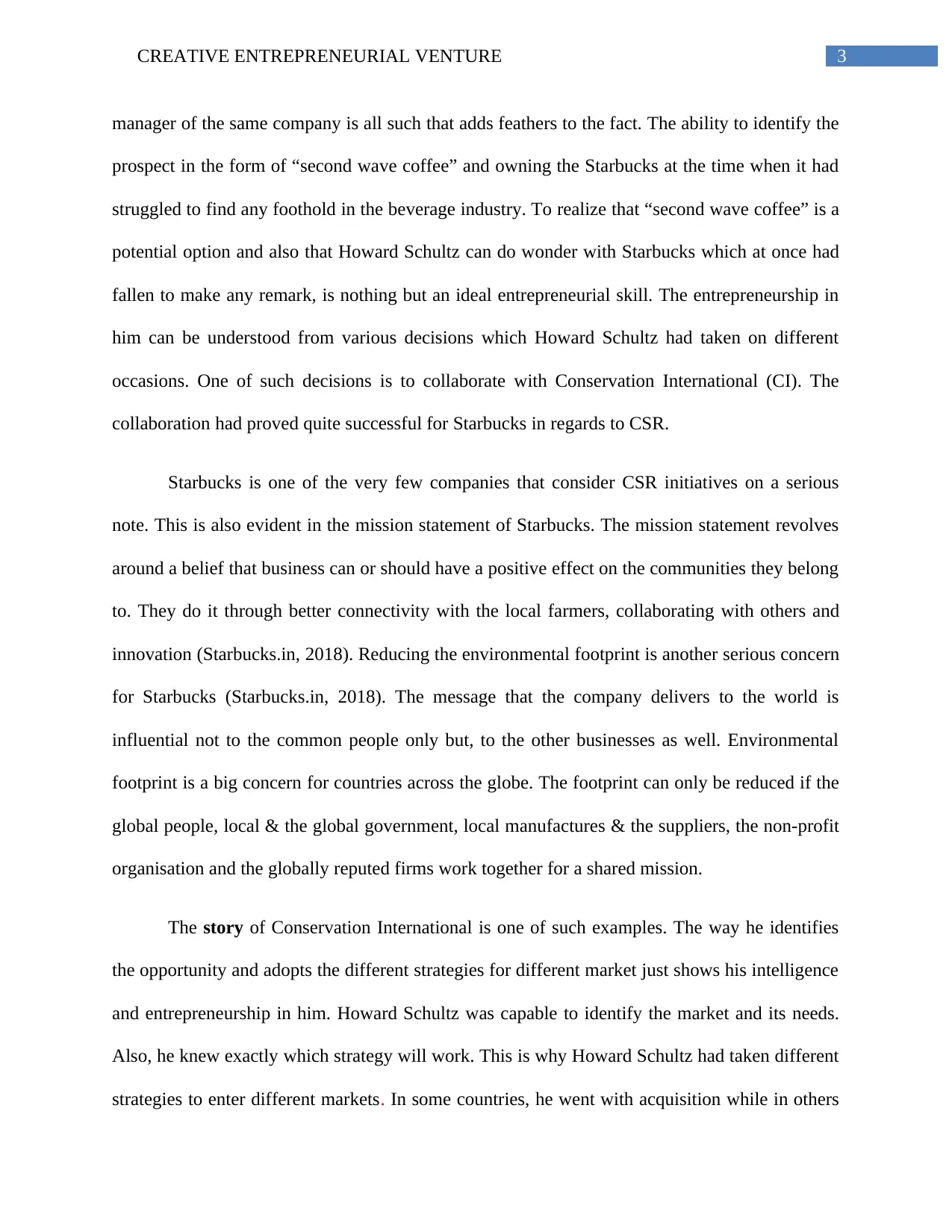
3CREATIVE ENTREPRENEURIAL VENTURE
manager of the same company is all such that adds feathers to the fact. The ability to identify the
prospect in the form of “second wave coffee” and owning the Starbucks at the time when it had
struggled to find any foothold in the beverage industry. To realize that “second wave coffee” is a
potential option and also that Howard Schultz can do wonder with Starbucks which at once had
fallen to make any remark, is nothing but an ideal entrepreneurial skill. The entrepreneurship in
him can be understood from various decisions which Howard Schultz had taken on different
occasions. One of such decisions is to collaborate with Conservation International (CI). The
collaboration had proved quite successful for Starbucks in regards to CSR.
Starbucks is one of the very few companies that consider CSR initiatives on a serious
note. This is also evident in the mission statement of Starbucks. The mission statement revolves
around a belief that business can or should have a positive effect on the communities they belong
to. They do it through better connectivity with the local farmers, collaborating with others and
innovation (Starbucks.in, 2018). Reducing the environmental footprint is another serious concern
for Starbucks (Starbucks.in, 2018). The message that the company delivers to the world is
influential not to the common people only but, to the other businesses as well. Environmental
footprint is a big concern for countries across the globe. The footprint can only be reduced if the
global people, local & the global government, local manufactures & the suppliers, the non-profit
organisation and the globally reputed firms work together for a shared mission.
The story of Conservation International is one of such examples. The way he identifies
the opportunity and adopts the different strategies for different market just shows his intelligence
and entrepreneurship in him. Howard Schultz was capable to identify the market and its needs.
Also, he knew exactly which strategy will work. This is why Howard Schultz had taken different
strategies to enter different markets. In some countries, he went with acquisition while in others
manager of the same company is all such that adds feathers to the fact. The ability to identify the
prospect in the form of “second wave coffee” and owning the Starbucks at the time when it had
struggled to find any foothold in the beverage industry. To realize that “second wave coffee” is a
potential option and also that Howard Schultz can do wonder with Starbucks which at once had
fallen to make any remark, is nothing but an ideal entrepreneurial skill. The entrepreneurship in
him can be understood from various decisions which Howard Schultz had taken on different
occasions. One of such decisions is to collaborate with Conservation International (CI). The
collaboration had proved quite successful for Starbucks in regards to CSR.
Starbucks is one of the very few companies that consider CSR initiatives on a serious
note. This is also evident in the mission statement of Starbucks. The mission statement revolves
around a belief that business can or should have a positive effect on the communities they belong
to. They do it through better connectivity with the local farmers, collaborating with others and
innovation (Starbucks.in, 2018). Reducing the environmental footprint is another serious concern
for Starbucks (Starbucks.in, 2018). The message that the company delivers to the world is
influential not to the common people only but, to the other businesses as well. Environmental
footprint is a big concern for countries across the globe. The footprint can only be reduced if the
global people, local & the global government, local manufactures & the suppliers, the non-profit
organisation and the globally reputed firms work together for a shared mission.
The story of Conservation International is one of such examples. The way he identifies
the opportunity and adopts the different strategies for different market just shows his intelligence
and entrepreneurship in him. Howard Schultz was capable to identify the market and its needs.
Also, he knew exactly which strategy will work. This is why Howard Schultz had taken different
strategies to enter different markets. In some countries, he went with acquisition while in others
Secure Best Marks with AI Grader
Need help grading? Try our AI Grader for instant feedback on your assignments.
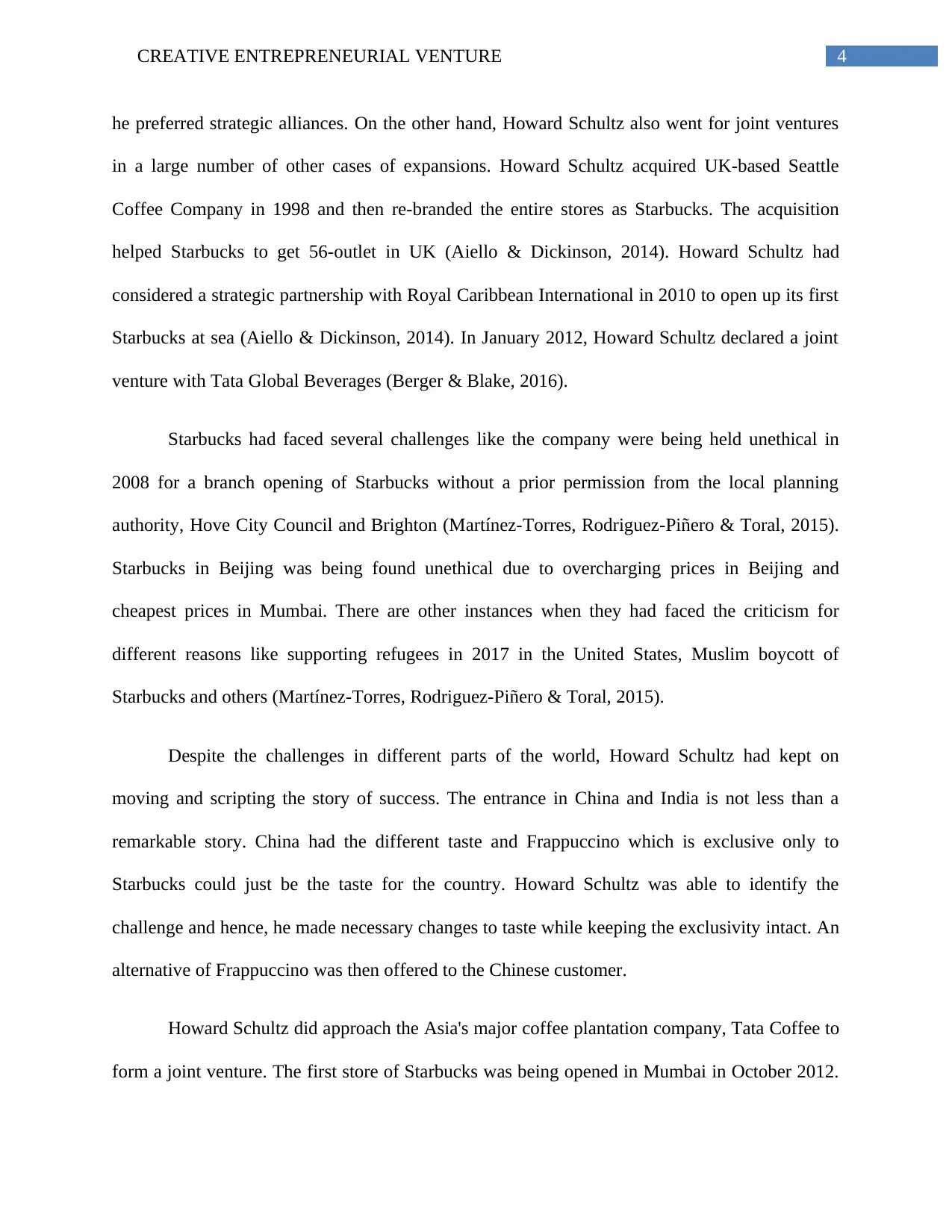
4CREATIVE ENTREPRENEURIAL VENTURE
he preferred strategic alliances. On the other hand, Howard Schultz also went for joint ventures
in a large number of other cases of expansions. Howard Schultz acquired UK-based Seattle
Coffee Company in 1998 and then re-branded the entire stores as Starbucks. The acquisition
helped Starbucks to get 56-outlet in UK (Aiello & Dickinson, 2014). Howard Schultz had
considered a strategic partnership with Royal Caribbean International in 2010 to open up its first
Starbucks at sea (Aiello & Dickinson, 2014). In January 2012, Howard Schultz declared a joint
venture with Tata Global Beverages (Berger & Blake, 2016).
Starbucks had faced several challenges like the company were being held unethical in
2008 for a branch opening of Starbucks without a prior permission from the local planning
authority, Hove City Council and Brighton (Martínez-Torres, Rodriguez-Piñero & Toral, 2015).
Starbucks in Beijing was being found unethical due to overcharging prices in Beijing and
cheapest prices in Mumbai. There are other instances when they had faced the criticism for
different reasons like supporting refugees in 2017 in the United States, Muslim boycott of
Starbucks and others (Martínez-Torres, Rodriguez-Piñero & Toral, 2015).
Despite the challenges in different parts of the world, Howard Schultz had kept on
moving and scripting the story of success. The entrance in China and India is not less than a
remarkable story. China had the different taste and Frappuccino which is exclusive only to
Starbucks could just be the taste for the country. Howard Schultz was able to identify the
challenge and hence, he made necessary changes to taste while keeping the exclusivity intact. An
alternative of Frappuccino was then offered to the Chinese customer.
Howard Schultz did approach the Asia's major coffee plantation company, Tata Coffee to
form a joint venture. The first store of Starbucks was being opened in Mumbai in October 2012.
he preferred strategic alliances. On the other hand, Howard Schultz also went for joint ventures
in a large number of other cases of expansions. Howard Schultz acquired UK-based Seattle
Coffee Company in 1998 and then re-branded the entire stores as Starbucks. The acquisition
helped Starbucks to get 56-outlet in UK (Aiello & Dickinson, 2014). Howard Schultz had
considered a strategic partnership with Royal Caribbean International in 2010 to open up its first
Starbucks at sea (Aiello & Dickinson, 2014). In January 2012, Howard Schultz declared a joint
venture with Tata Global Beverages (Berger & Blake, 2016).
Starbucks had faced several challenges like the company were being held unethical in
2008 for a branch opening of Starbucks without a prior permission from the local planning
authority, Hove City Council and Brighton (Martínez-Torres, Rodriguez-Piñero & Toral, 2015).
Starbucks in Beijing was being found unethical due to overcharging prices in Beijing and
cheapest prices in Mumbai. There are other instances when they had faced the criticism for
different reasons like supporting refugees in 2017 in the United States, Muslim boycott of
Starbucks and others (Martínez-Torres, Rodriguez-Piñero & Toral, 2015).
Despite the challenges in different parts of the world, Howard Schultz had kept on
moving and scripting the story of success. The entrance in China and India is not less than a
remarkable story. China had the different taste and Frappuccino which is exclusive only to
Starbucks could just be the taste for the country. Howard Schultz was able to identify the
challenge and hence, he made necessary changes to taste while keeping the exclusivity intact. An
alternative of Frappuccino was then offered to the Chinese customer.
Howard Schultz did approach the Asia's major coffee plantation company, Tata Coffee to
form a joint venture. The first store of Starbucks was being opened in Mumbai in October 2012.
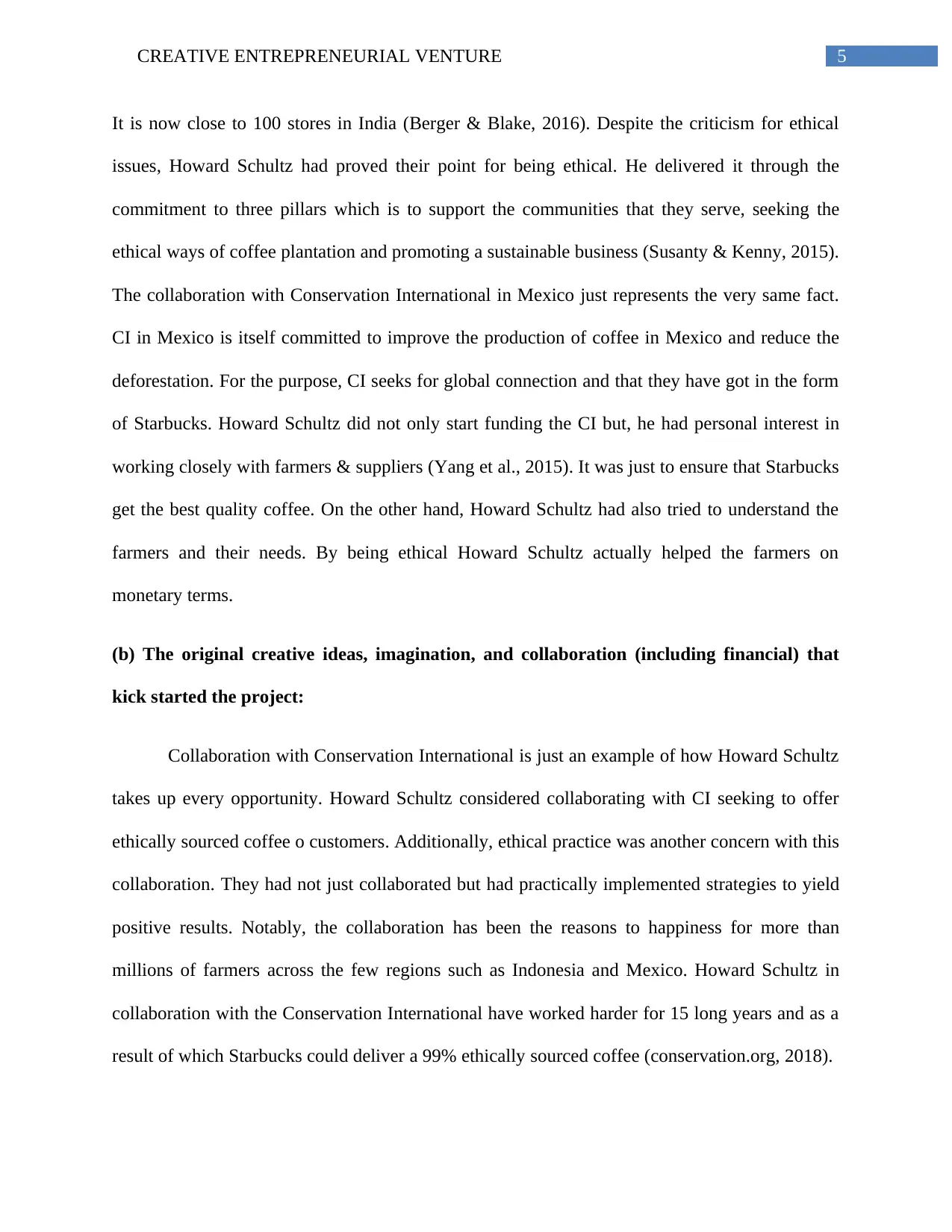
5CREATIVE ENTREPRENEURIAL VENTURE
It is now close to 100 stores in India (Berger & Blake, 2016). Despite the criticism for ethical
issues, Howard Schultz had proved their point for being ethical. He delivered it through the
commitment to three pillars which is to support the communities that they serve, seeking the
ethical ways of coffee plantation and promoting a sustainable business (Susanty & Kenny, 2015).
The collaboration with Conservation International in Mexico just represents the very same fact.
CI in Mexico is itself committed to improve the production of coffee in Mexico and reduce the
deforestation. For the purpose, CI seeks for global connection and that they have got in the form
of Starbucks. Howard Schultz did not only start funding the CI but, he had personal interest in
working closely with farmers & suppliers (Yang et al., 2015). It was just to ensure that Starbucks
get the best quality coffee. On the other hand, Howard Schultz had also tried to understand the
farmers and their needs. By being ethical Howard Schultz actually helped the farmers on
monetary terms.
(b) The original creative ideas, imagination, and collaboration (including financial) that
kick started the project:
Collaboration with Conservation International is just an example of how Howard Schultz
takes up every opportunity. Howard Schultz considered collaborating with CI seeking to offer
ethically sourced coffee o customers. Additionally, ethical practice was another concern with this
collaboration. They had not just collaborated but had practically implemented strategies to yield
positive results. Notably, the collaboration has been the reasons to happiness for more than
millions of farmers across the few regions such as Indonesia and Mexico. Howard Schultz in
collaboration with the Conservation International have worked harder for 15 long years and as a
result of which Starbucks could deliver a 99% ethically sourced coffee (conservation.org, 2018).
It is now close to 100 stores in India (Berger & Blake, 2016). Despite the criticism for ethical
issues, Howard Schultz had proved their point for being ethical. He delivered it through the
commitment to three pillars which is to support the communities that they serve, seeking the
ethical ways of coffee plantation and promoting a sustainable business (Susanty & Kenny, 2015).
The collaboration with Conservation International in Mexico just represents the very same fact.
CI in Mexico is itself committed to improve the production of coffee in Mexico and reduce the
deforestation. For the purpose, CI seeks for global connection and that they have got in the form
of Starbucks. Howard Schultz did not only start funding the CI but, he had personal interest in
working closely with farmers & suppliers (Yang et al., 2015). It was just to ensure that Starbucks
get the best quality coffee. On the other hand, Howard Schultz had also tried to understand the
farmers and their needs. By being ethical Howard Schultz actually helped the farmers on
monetary terms.
(b) The original creative ideas, imagination, and collaboration (including financial) that
kick started the project:
Collaboration with Conservation International is just an example of how Howard Schultz
takes up every opportunity. Howard Schultz considered collaborating with CI seeking to offer
ethically sourced coffee o customers. Additionally, ethical practice was another concern with this
collaboration. They had not just collaborated but had practically implemented strategies to yield
positive results. Notably, the collaboration has been the reasons to happiness for more than
millions of farmers across the few regions such as Indonesia and Mexico. Howard Schultz in
collaboration with the Conservation International have worked harder for 15 long years and as a
result of which Starbucks could deliver a 99% ethically sourced coffee (conservation.org, 2018).
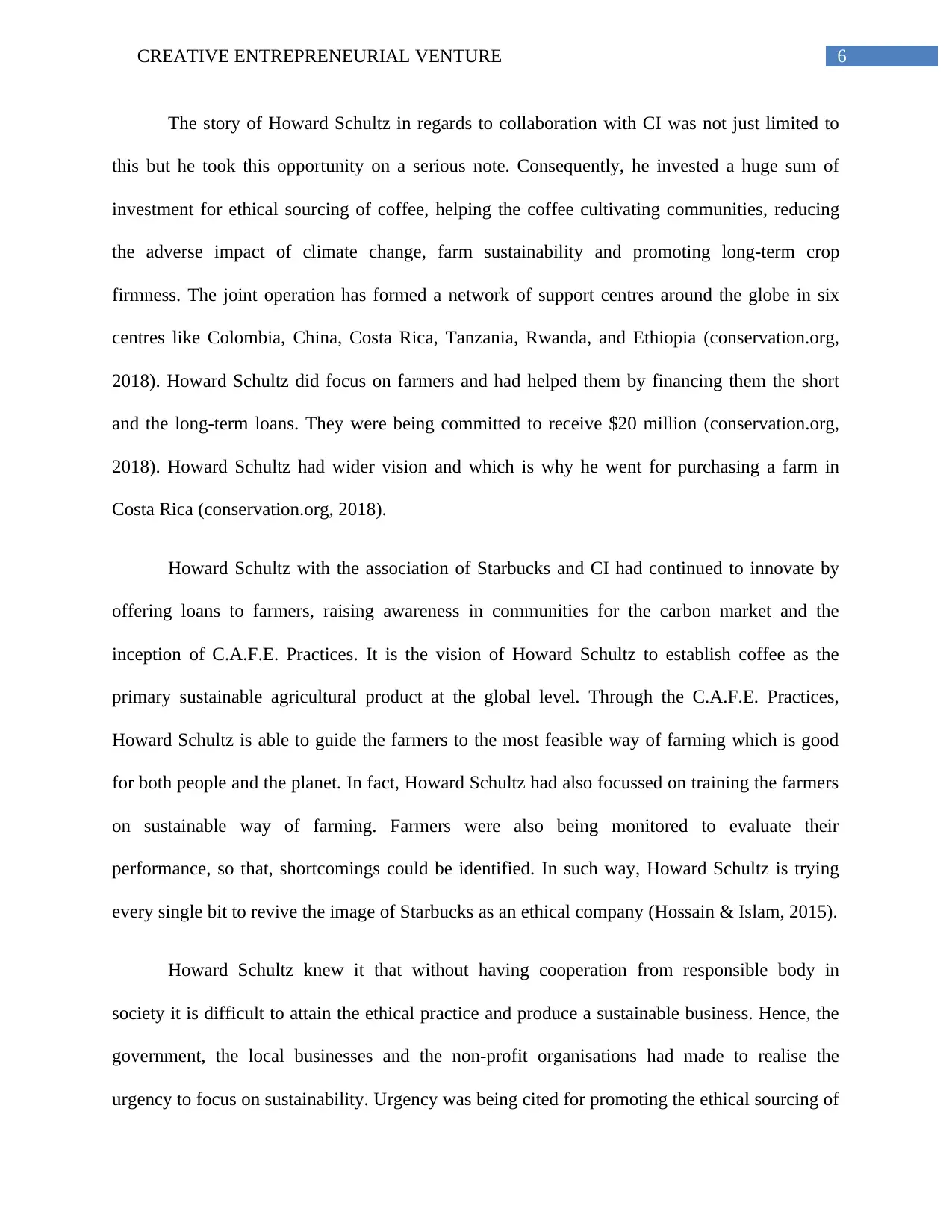
6CREATIVE ENTREPRENEURIAL VENTURE
The story of Howard Schultz in regards to collaboration with CI was not just limited to
this but he took this opportunity on a serious note. Consequently, he invested a huge sum of
investment for ethical sourcing of coffee, helping the coffee cultivating communities, reducing
the adverse impact of climate change, farm sustainability and promoting long-term crop
firmness. The joint operation has formed a network of support centres around the globe in six
centres like Colombia, China, Costa Rica, Tanzania, Rwanda, and Ethiopia (conservation.org,
2018). Howard Schultz did focus on farmers and had helped them by financing them the short
and the long-term loans. They were being committed to receive $20 million (conservation.org,
2018). Howard Schultz had wider vision and which is why he went for purchasing a farm in
Costa Rica (conservation.org, 2018).
Howard Schultz with the association of Starbucks and CI had continued to innovate by
offering loans to farmers, raising awareness in communities for the carbon market and the
inception of C.A.F.E. Practices. It is the vision of Howard Schultz to establish coffee as the
primary sustainable agricultural product at the global level. Through the C.A.F.E. Practices,
Howard Schultz is able to guide the farmers to the most feasible way of farming which is good
for both people and the planet. In fact, Howard Schultz had also focussed on training the farmers
on sustainable way of farming. Farmers were also being monitored to evaluate their
performance, so that, shortcomings could be identified. In such way, Howard Schultz is trying
every single bit to revive the image of Starbucks as an ethical company (Hossain & Islam, 2015).
Howard Schultz knew it that without having cooperation from responsible body in
society it is difficult to attain the ethical practice and produce a sustainable business. Hence, the
government, the local businesses and the non-profit organisations had made to realise the
urgency to focus on sustainability. Urgency was being cited for promoting the ethical sourcing of
The story of Howard Schultz in regards to collaboration with CI was not just limited to
this but he took this opportunity on a serious note. Consequently, he invested a huge sum of
investment for ethical sourcing of coffee, helping the coffee cultivating communities, reducing
the adverse impact of climate change, farm sustainability and promoting long-term crop
firmness. The joint operation has formed a network of support centres around the globe in six
centres like Colombia, China, Costa Rica, Tanzania, Rwanda, and Ethiopia (conservation.org,
2018). Howard Schultz did focus on farmers and had helped them by financing them the short
and the long-term loans. They were being committed to receive $20 million (conservation.org,
2018). Howard Schultz had wider vision and which is why he went for purchasing a farm in
Costa Rica (conservation.org, 2018).
Howard Schultz with the association of Starbucks and CI had continued to innovate by
offering loans to farmers, raising awareness in communities for the carbon market and the
inception of C.A.F.E. Practices. It is the vision of Howard Schultz to establish coffee as the
primary sustainable agricultural product at the global level. Through the C.A.F.E. Practices,
Howard Schultz is able to guide the farmers to the most feasible way of farming which is good
for both people and the planet. In fact, Howard Schultz had also focussed on training the farmers
on sustainable way of farming. Farmers were also being monitored to evaluate their
performance, so that, shortcomings could be identified. In such way, Howard Schultz is trying
every single bit to revive the image of Starbucks as an ethical company (Hossain & Islam, 2015).
Howard Schultz knew it that without having cooperation from responsible body in
society it is difficult to attain the ethical practice and produce a sustainable business. Hence, the
government, the local businesses and the non-profit organisations had made to realise the
urgency to focus on sustainability. Urgency was being cited for promoting the ethical sourcing of
Paraphrase This Document
Need a fresh take? Get an instant paraphrase of this document with our AI Paraphraser
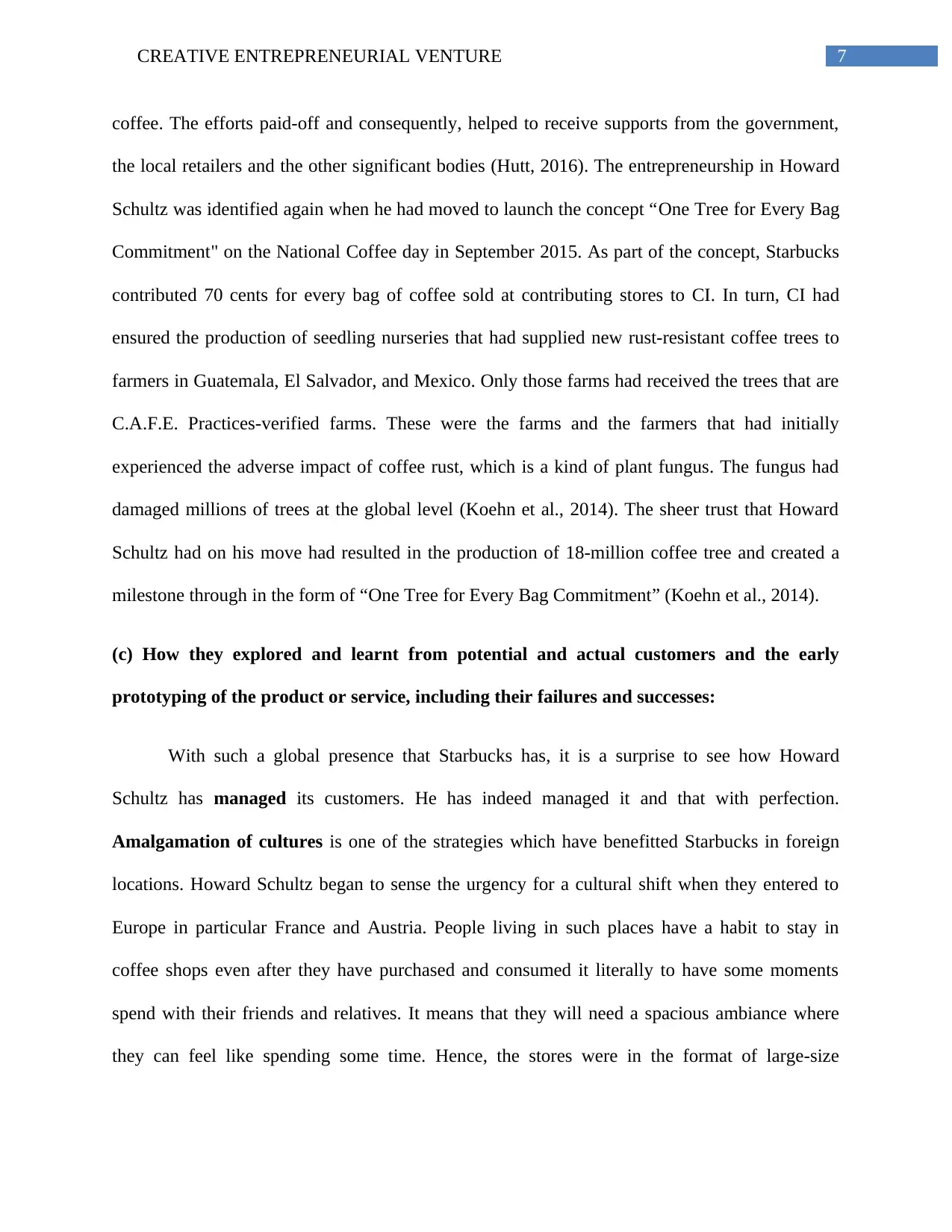
7CREATIVE ENTREPRENEURIAL VENTURE
coffee. The efforts paid-off and consequently, helped to receive supports from the government,
the local retailers and the other significant bodies (Hutt, 2016). The entrepreneurship in Howard
Schultz was identified again when he had moved to launch the concept “One Tree for Every Bag
Commitment" on the National Coffee day in September 2015. As part of the concept, Starbucks
contributed 70 cents for every bag of coffee sold at contributing stores to CI. In turn, CI had
ensured the production of seedling nurseries that had supplied new rust-resistant coffee trees to
farmers in Guatemala, El Salvador, and Mexico. Only those farms had received the trees that are
C.A.F.E. Practices-verified farms. These were the farms and the farmers that had initially
experienced the adverse impact of coffee rust, which is a kind of plant fungus. The fungus had
damaged millions of trees at the global level (Koehn et al., 2014). The sheer trust that Howard
Schultz had on his move had resulted in the production of 18-million coffee tree and created a
milestone through in the form of “One Tree for Every Bag Commitment” (Koehn et al., 2014).
(c) How they explored and learnt from potential and actual customers and the early
prototyping of the product or service, including their failures and successes:
With such a global presence that Starbucks has, it is a surprise to see how Howard
Schultz has managed its customers. He has indeed managed it and that with perfection.
Amalgamation of cultures is one of the strategies which have benefitted Starbucks in foreign
locations. Howard Schultz began to sense the urgency for a cultural shift when they entered to
Europe in particular France and Austria. People living in such places have a habit to stay in
coffee shops even after they have purchased and consumed it literally to have some moments
spend with their friends and relatives. It means that they will need a spacious ambiance where
they can feel like spending some time. Hence, the stores were in the format of large-size
coffee. The efforts paid-off and consequently, helped to receive supports from the government,
the local retailers and the other significant bodies (Hutt, 2016). The entrepreneurship in Howard
Schultz was identified again when he had moved to launch the concept “One Tree for Every Bag
Commitment" on the National Coffee day in September 2015. As part of the concept, Starbucks
contributed 70 cents for every bag of coffee sold at contributing stores to CI. In turn, CI had
ensured the production of seedling nurseries that had supplied new rust-resistant coffee trees to
farmers in Guatemala, El Salvador, and Mexico. Only those farms had received the trees that are
C.A.F.E. Practices-verified farms. These were the farms and the farmers that had initially
experienced the adverse impact of coffee rust, which is a kind of plant fungus. The fungus had
damaged millions of trees at the global level (Koehn et al., 2014). The sheer trust that Howard
Schultz had on his move had resulted in the production of 18-million coffee tree and created a
milestone through in the form of “One Tree for Every Bag Commitment” (Koehn et al., 2014).
(c) How they explored and learnt from potential and actual customers and the early
prototyping of the product or service, including their failures and successes:
With such a global presence that Starbucks has, it is a surprise to see how Howard
Schultz has managed its customers. He has indeed managed it and that with perfection.
Amalgamation of cultures is one of the strategies which have benefitted Starbucks in foreign
locations. Howard Schultz began to sense the urgency for a cultural shift when they entered to
Europe in particular France and Austria. People living in such places have a habit to stay in
coffee shops even after they have purchased and consumed it literally to have some moments
spend with their friends and relatives. It means that they will need a spacious ambiance where
they can feel like spending some time. Hence, the stores were in the format of large-size
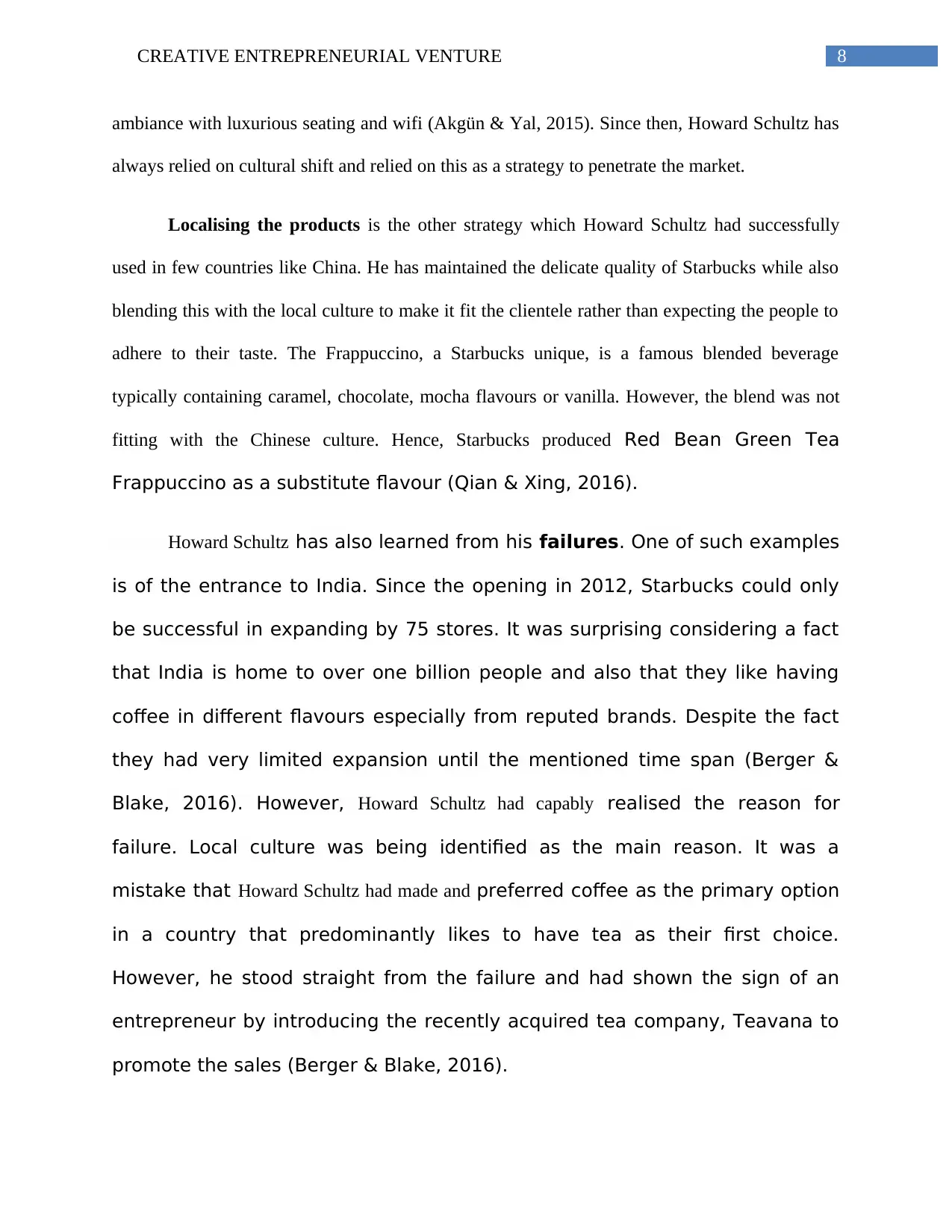
8CREATIVE ENTREPRENEURIAL VENTURE
ambiance with luxurious seating and wifi (Akgün & Yal, 2015). Since then, Howard Schultz has
always relied on cultural shift and relied on this as a strategy to penetrate the market.
Localising the products is the other strategy which Howard Schultz had successfully
used in few countries like China. He has maintained the delicate quality of Starbucks while also
blending this with the local culture to make it fit the clientele rather than expecting the people to
adhere to their taste. The Frappuccino, a Starbucks unique, is a famous blended beverage
typically containing caramel, chocolate, mocha flavours or vanilla. However, the blend was not
fitting with the Chinese culture. Hence, Starbucks produced Red Bean Green Tea
Frappuccino as a substitute flavour (Qian & Xing, 2016).
Howard Schultz has also learned from his failures. One of such examples
is of the entrance to India. Since the opening in 2012, Starbucks could only
be successful in expanding by 75 stores. It was surprising considering a fact
that India is home to over one billion people and also that they like having
coffee in different flavours especially from reputed brands. Despite the fact
they had very limited expansion until the mentioned time span (Berger &
Blake, 2016). However, Howard Schultz had capably realised the reason for
failure. Local culture was being identified as the main reason. It was a
mistake that Howard Schultz had made and preferred coffee as the primary option
in a country that predominantly likes to have tea as their first choice.
However, he stood straight from the failure and had shown the sign of an
entrepreneur by introducing the recently acquired tea company, Teavana to
promote the sales (Berger & Blake, 2016).
ambiance with luxurious seating and wifi (Akgün & Yal, 2015). Since then, Howard Schultz has
always relied on cultural shift and relied on this as a strategy to penetrate the market.
Localising the products is the other strategy which Howard Schultz had successfully
used in few countries like China. He has maintained the delicate quality of Starbucks while also
blending this with the local culture to make it fit the clientele rather than expecting the people to
adhere to their taste. The Frappuccino, a Starbucks unique, is a famous blended beverage
typically containing caramel, chocolate, mocha flavours or vanilla. However, the blend was not
fitting with the Chinese culture. Hence, Starbucks produced Red Bean Green Tea
Frappuccino as a substitute flavour (Qian & Xing, 2016).
Howard Schultz has also learned from his failures. One of such examples
is of the entrance to India. Since the opening in 2012, Starbucks could only
be successful in expanding by 75 stores. It was surprising considering a fact
that India is home to over one billion people and also that they like having
coffee in different flavours especially from reputed brands. Despite the fact
they had very limited expansion until the mentioned time span (Berger &
Blake, 2016). However, Howard Schultz had capably realised the reason for
failure. Local culture was being identified as the main reason. It was a
mistake that Howard Schultz had made and preferred coffee as the primary option
in a country that predominantly likes to have tea as their first choice.
However, he stood straight from the failure and had shown the sign of an
entrepreneur by introducing the recently acquired tea company, Teavana to
promote the sales (Berger & Blake, 2016).
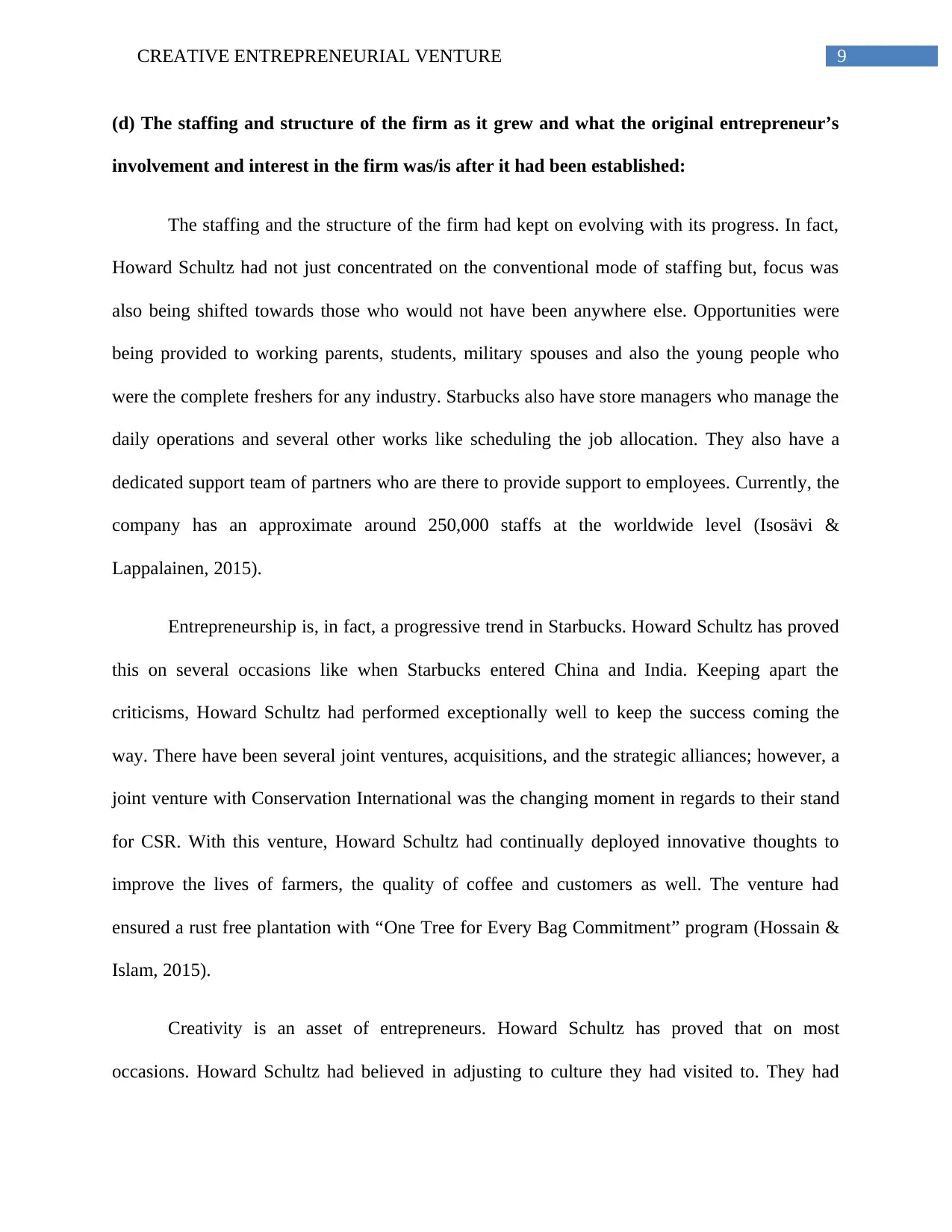
9CREATIVE ENTREPRENEURIAL VENTURE
(d) The staffing and structure of the firm as it grew and what the original entrepreneur’s
involvement and interest in the firm was/is after it had been established:
The staffing and the structure of the firm had kept on evolving with its progress. In fact,
Howard Schultz had not just concentrated on the conventional mode of staffing but, focus was
also being shifted towards those who would not have been anywhere else. Opportunities were
being provided to working parents, students, military spouses and also the young people who
were the complete freshers for any industry. Starbucks also have store managers who manage the
daily operations and several other works like scheduling the job allocation. They also have a
dedicated support team of partners who are there to provide support to employees. Currently, the
company has an approximate around 250,000 staffs at the worldwide level (Isosävi &
Lappalainen, 2015).
Entrepreneurship is, in fact, a progressive trend in Starbucks. Howard Schultz has proved
this on several occasions like when Starbucks entered China and India. Keeping apart the
criticisms, Howard Schultz had performed exceptionally well to keep the success coming the
way. There have been several joint ventures, acquisitions, and the strategic alliances; however, a
joint venture with Conservation International was the changing moment in regards to their stand
for CSR. With this venture, Howard Schultz had continually deployed innovative thoughts to
improve the lives of farmers, the quality of coffee and customers as well. The venture had
ensured a rust free plantation with “One Tree for Every Bag Commitment” program (Hossain &
Islam, 2015).
Creativity is an asset of entrepreneurs. Howard Schultz has proved that on most
occasions. Howard Schultz had believed in adjusting to culture they had visited to. They had
(d) The staffing and structure of the firm as it grew and what the original entrepreneur’s
involvement and interest in the firm was/is after it had been established:
The staffing and the structure of the firm had kept on evolving with its progress. In fact,
Howard Schultz had not just concentrated on the conventional mode of staffing but, focus was
also being shifted towards those who would not have been anywhere else. Opportunities were
being provided to working parents, students, military spouses and also the young people who
were the complete freshers for any industry. Starbucks also have store managers who manage the
daily operations and several other works like scheduling the job allocation. They also have a
dedicated support team of partners who are there to provide support to employees. Currently, the
company has an approximate around 250,000 staffs at the worldwide level (Isosävi &
Lappalainen, 2015).
Entrepreneurship is, in fact, a progressive trend in Starbucks. Howard Schultz has proved
this on several occasions like when Starbucks entered China and India. Keeping apart the
criticisms, Howard Schultz had performed exceptionally well to keep the success coming the
way. There have been several joint ventures, acquisitions, and the strategic alliances; however, a
joint venture with Conservation International was the changing moment in regards to their stand
for CSR. With this venture, Howard Schultz had continually deployed innovative thoughts to
improve the lives of farmers, the quality of coffee and customers as well. The venture had
ensured a rust free plantation with “One Tree for Every Bag Commitment” program (Hossain &
Islam, 2015).
Creativity is an asset of entrepreneurs. Howard Schultz has proved that on most
occasions. Howard Schultz had believed in adjusting to culture they had visited to. They had
Secure Best Marks with AI Grader
Need help grading? Try our AI Grader for instant feedback on your assignments.
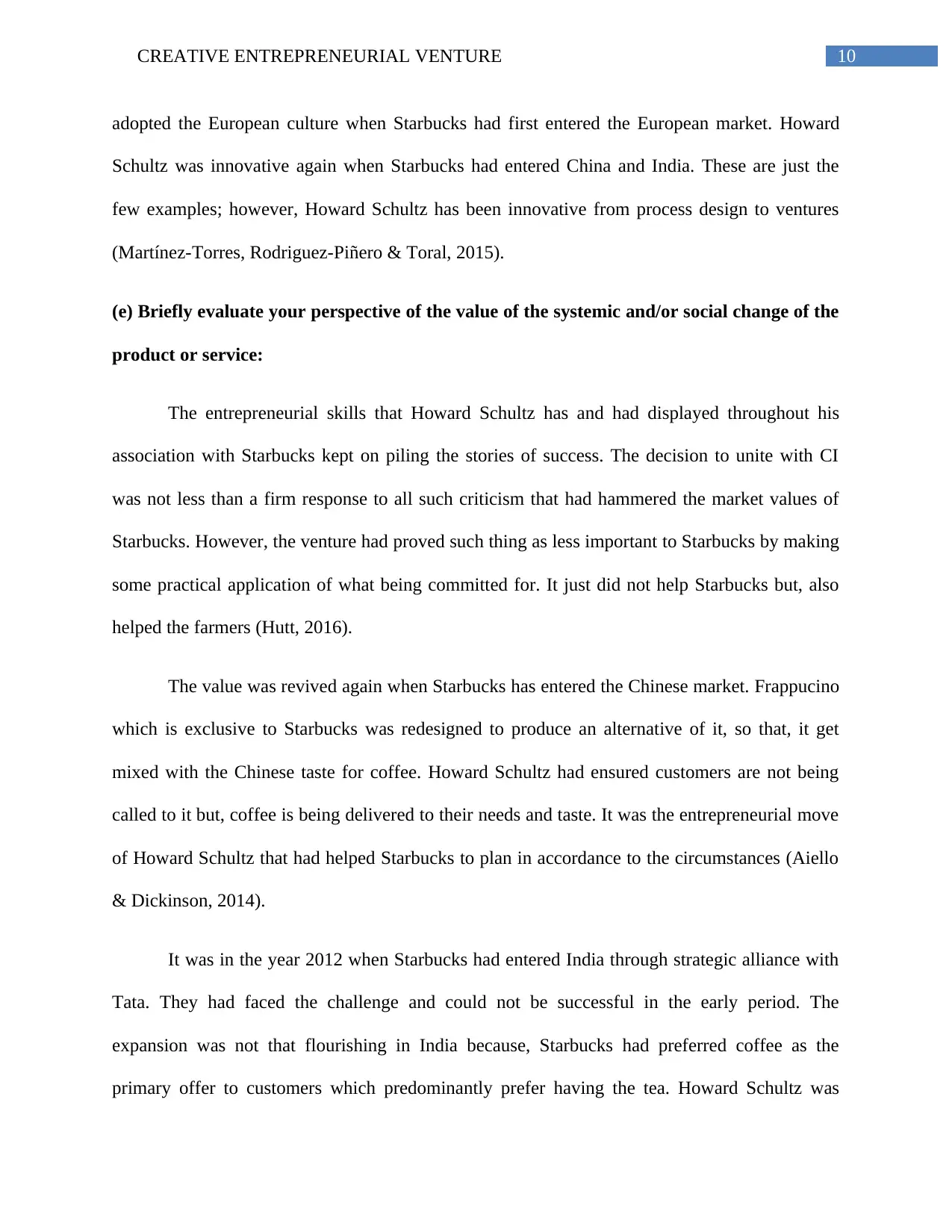
10CREATIVE ENTREPRENEURIAL VENTURE
adopted the European culture when Starbucks had first entered the European market. Howard
Schultz was innovative again when Starbucks had entered China and India. These are just the
few examples; however, Howard Schultz has been innovative from process design to ventures
(Martínez-Torres, Rodriguez-Piñero & Toral, 2015).
(e) Briefly evaluate your perspective of the value of the systemic and/or social change of the
product or service:
The entrepreneurial skills that Howard Schultz has and had displayed throughout his
association with Starbucks kept on piling the stories of success. The decision to unite with CI
was not less than a firm response to all such criticism that had hammered the market values of
Starbucks. However, the venture had proved such thing as less important to Starbucks by making
some practical application of what being committed for. It just did not help Starbucks but, also
helped the farmers (Hutt, 2016).
The value was revived again when Starbucks has entered the Chinese market. Frappucino
which is exclusive to Starbucks was redesigned to produce an alternative of it, so that, it get
mixed with the Chinese taste for coffee. Howard Schultz had ensured customers are not being
called to it but, coffee is being delivered to their needs and taste. It was the entrepreneurial move
of Howard Schultz that had helped Starbucks to plan in accordance to the circumstances (Aiello
& Dickinson, 2014).
It was in the year 2012 when Starbucks had entered India through strategic alliance with
Tata. They had faced the challenge and could not be successful in the early period. The
expansion was not that flourishing in India because, Starbucks had preferred coffee as the
primary offer to customers which predominantly prefer having the tea. Howard Schultz was
adopted the European culture when Starbucks had first entered the European market. Howard
Schultz was innovative again when Starbucks had entered China and India. These are just the
few examples; however, Howard Schultz has been innovative from process design to ventures
(Martínez-Torres, Rodriguez-Piñero & Toral, 2015).
(e) Briefly evaluate your perspective of the value of the systemic and/or social change of the
product or service:
The entrepreneurial skills that Howard Schultz has and had displayed throughout his
association with Starbucks kept on piling the stories of success. The decision to unite with CI
was not less than a firm response to all such criticism that had hammered the market values of
Starbucks. However, the venture had proved such thing as less important to Starbucks by making
some practical application of what being committed for. It just did not help Starbucks but, also
helped the farmers (Hutt, 2016).
The value was revived again when Starbucks has entered the Chinese market. Frappucino
which is exclusive to Starbucks was redesigned to produce an alternative of it, so that, it get
mixed with the Chinese taste for coffee. Howard Schultz had ensured customers are not being
called to it but, coffee is being delivered to their needs and taste. It was the entrepreneurial move
of Howard Schultz that had helped Starbucks to plan in accordance to the circumstances (Aiello
& Dickinson, 2014).
It was in the year 2012 when Starbucks had entered India through strategic alliance with
Tata. They had faced the challenge and could not be successful in the early period. The
expansion was not that flourishing in India because, Starbucks had preferred coffee as the
primary offer to customers which predominantly prefer having the tea. Howard Schultz was
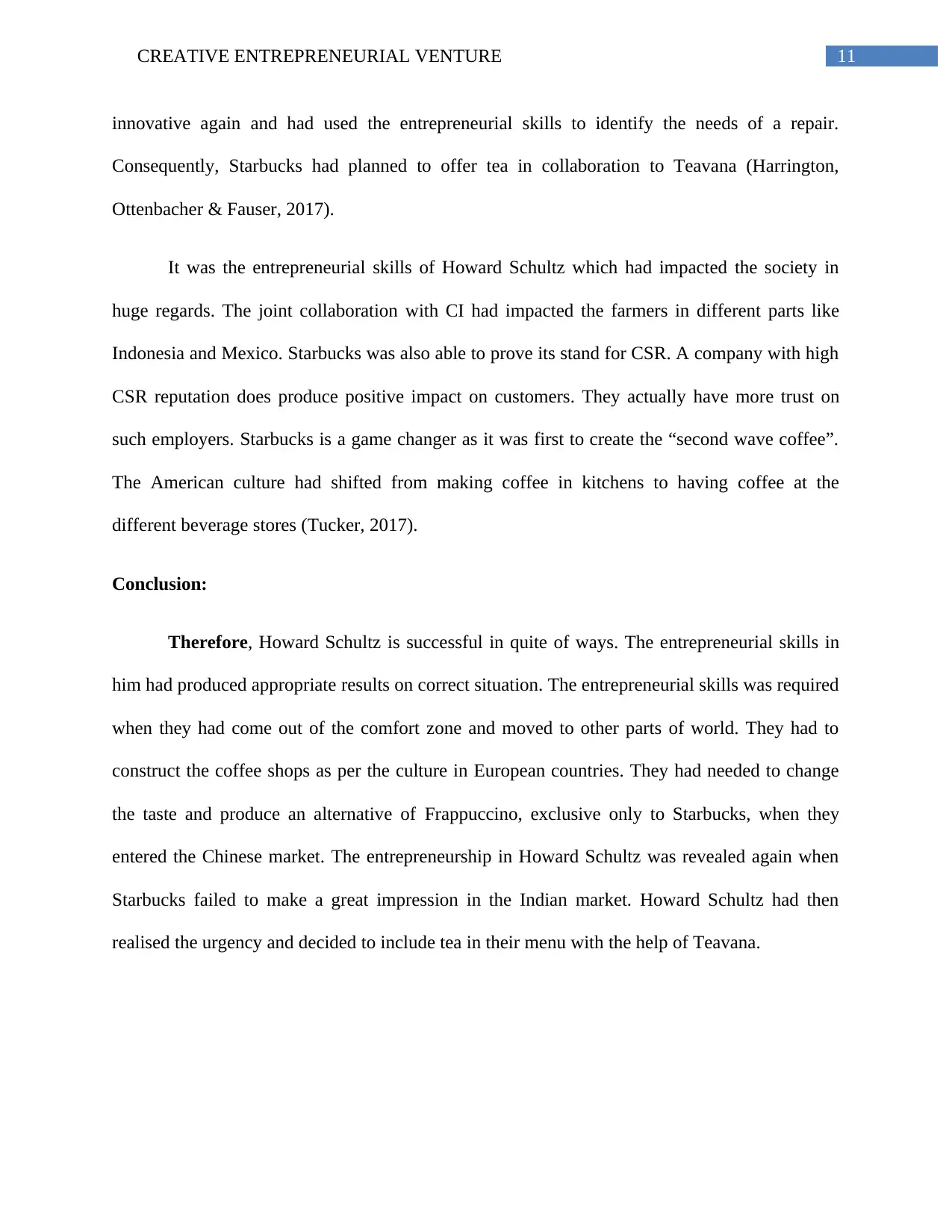
11CREATIVE ENTREPRENEURIAL VENTURE
innovative again and had used the entrepreneurial skills to identify the needs of a repair.
Consequently, Starbucks had planned to offer tea in collaboration to Teavana (Harrington,
Ottenbacher & Fauser, 2017).
It was the entrepreneurial skills of Howard Schultz which had impacted the society in
huge regards. The joint collaboration with CI had impacted the farmers in different parts like
Indonesia and Mexico. Starbucks was also able to prove its stand for CSR. A company with high
CSR reputation does produce positive impact on customers. They actually have more trust on
such employers. Starbucks is a game changer as it was first to create the “second wave coffee”.
The American culture had shifted from making coffee in kitchens to having coffee at the
different beverage stores (Tucker, 2017).
Conclusion:
Therefore, Howard Schultz is successful in quite of ways. The entrepreneurial skills in
him had produced appropriate results on correct situation. The entrepreneurial skills was required
when they had come out of the comfort zone and moved to other parts of world. They had to
construct the coffee shops as per the culture in European countries. They had needed to change
the taste and produce an alternative of Frappuccino, exclusive only to Starbucks, when they
entered the Chinese market. The entrepreneurship in Howard Schultz was revealed again when
Starbucks failed to make a great impression in the Indian market. Howard Schultz had then
realised the urgency and decided to include tea in their menu with the help of Teavana.
innovative again and had used the entrepreneurial skills to identify the needs of a repair.
Consequently, Starbucks had planned to offer tea in collaboration to Teavana (Harrington,
Ottenbacher & Fauser, 2017).
It was the entrepreneurial skills of Howard Schultz which had impacted the society in
huge regards. The joint collaboration with CI had impacted the farmers in different parts like
Indonesia and Mexico. Starbucks was also able to prove its stand for CSR. A company with high
CSR reputation does produce positive impact on customers. They actually have more trust on
such employers. Starbucks is a game changer as it was first to create the “second wave coffee”.
The American culture had shifted from making coffee in kitchens to having coffee at the
different beverage stores (Tucker, 2017).
Conclusion:
Therefore, Howard Schultz is successful in quite of ways. The entrepreneurial skills in
him had produced appropriate results on correct situation. The entrepreneurial skills was required
when they had come out of the comfort zone and moved to other parts of world. They had to
construct the coffee shops as per the culture in European countries. They had needed to change
the taste and produce an alternative of Frappuccino, exclusive only to Starbucks, when they
entered the Chinese market. The entrepreneurship in Howard Schultz was revealed again when
Starbucks failed to make a great impression in the Indian market. Howard Schultz had then
realised the urgency and decided to include tea in their menu with the help of Teavana.
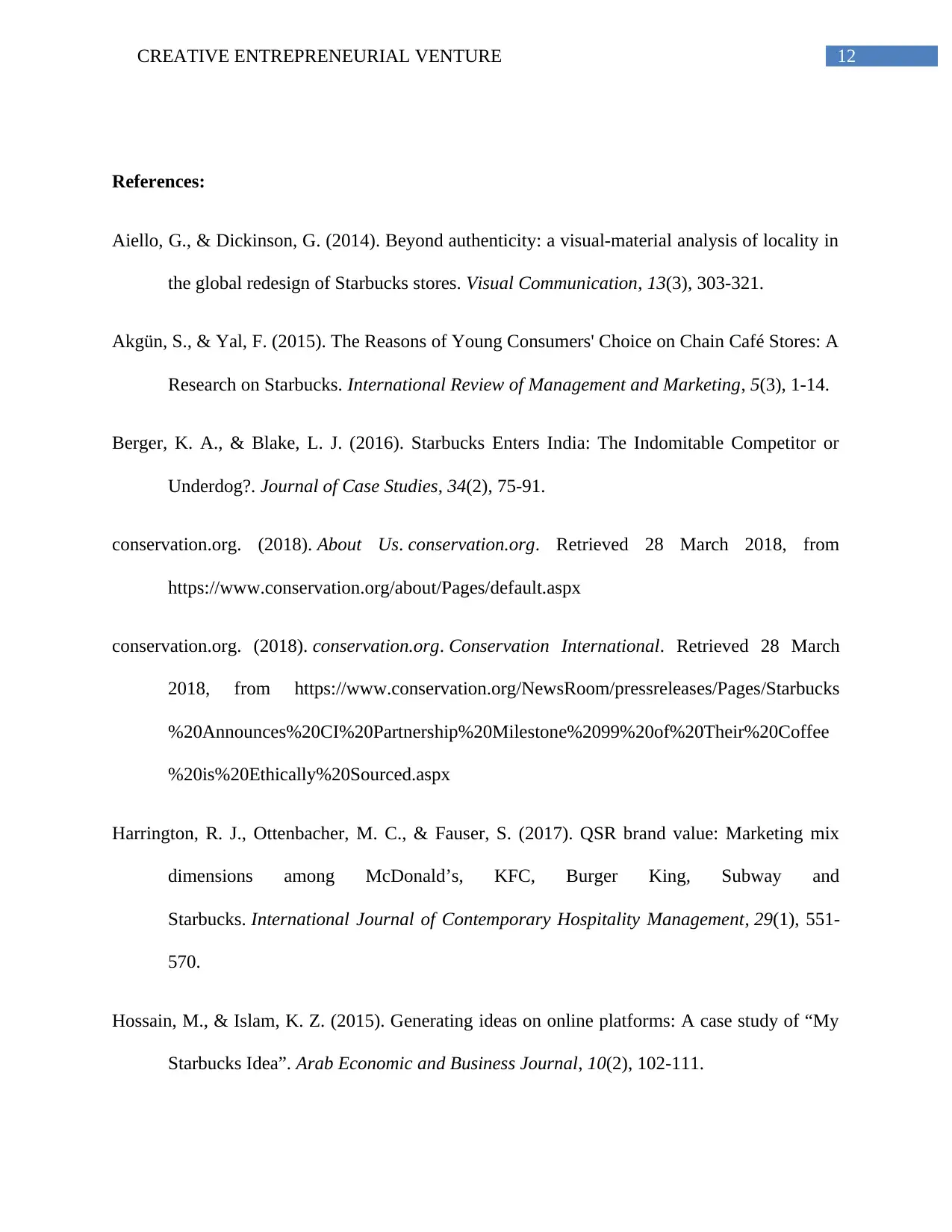
12CREATIVE ENTREPRENEURIAL VENTURE
References:
Aiello, G., & Dickinson, G. (2014). Beyond authenticity: a visual-material analysis of locality in
the global redesign of Starbucks stores. Visual Communication, 13(3), 303-321.
Akgün, S., & Yal, F. (2015). The Reasons of Young Consumers' Choice on Chain Café Stores: A
Research on Starbucks. International Review of Management and Marketing, 5(3), 1-14.
Berger, K. A., & Blake, L. J. (2016). Starbucks Enters India: The Indomitable Competitor or
Underdog?. Journal of Case Studies, 34(2), 75-91.
conservation.org. (2018). About Us. conservation.org. Retrieved 28 March 2018, from
https://www.conservation.org/about/Pages/default.aspx
conservation.org. (2018). conservation.org. Conservation International. Retrieved 28 March
2018, from https://www.conservation.org/NewsRoom/pressreleases/Pages/Starbucks
%20Announces%20CI%20Partnership%20Milestone%2099%20of%20Their%20Coffee
%20is%20Ethically%20Sourced.aspx
Harrington, R. J., Ottenbacher, M. C., & Fauser, S. (2017). QSR brand value: Marketing mix
dimensions among McDonald’s, KFC, Burger King, Subway and
Starbucks. International Journal of Contemporary Hospitality Management, 29(1), 551-
570.
Hossain, M., & Islam, K. Z. (2015). Generating ideas on online platforms: A case study of “My
Starbucks Idea”. Arab Economic and Business Journal, 10(2), 102-111.
References:
Aiello, G., & Dickinson, G. (2014). Beyond authenticity: a visual-material analysis of locality in
the global redesign of Starbucks stores. Visual Communication, 13(3), 303-321.
Akgün, S., & Yal, F. (2015). The Reasons of Young Consumers' Choice on Chain Café Stores: A
Research on Starbucks. International Review of Management and Marketing, 5(3), 1-14.
Berger, K. A., & Blake, L. J. (2016). Starbucks Enters India: The Indomitable Competitor or
Underdog?. Journal of Case Studies, 34(2), 75-91.
conservation.org. (2018). About Us. conservation.org. Retrieved 28 March 2018, from
https://www.conservation.org/about/Pages/default.aspx
conservation.org. (2018). conservation.org. Conservation International. Retrieved 28 March
2018, from https://www.conservation.org/NewsRoom/pressreleases/Pages/Starbucks
%20Announces%20CI%20Partnership%20Milestone%2099%20of%20Their%20Coffee
%20is%20Ethically%20Sourced.aspx
Harrington, R. J., Ottenbacher, M. C., & Fauser, S. (2017). QSR brand value: Marketing mix
dimensions among McDonald’s, KFC, Burger King, Subway and
Starbucks. International Journal of Contemporary Hospitality Management, 29(1), 551-
570.
Hossain, M., & Islam, K. Z. (2015). Generating ideas on online platforms: A case study of “My
Starbucks Idea”. Arab Economic and Business Journal, 10(2), 102-111.
Paraphrase This Document
Need a fresh take? Get an instant paraphrase of this document with our AI Paraphraser
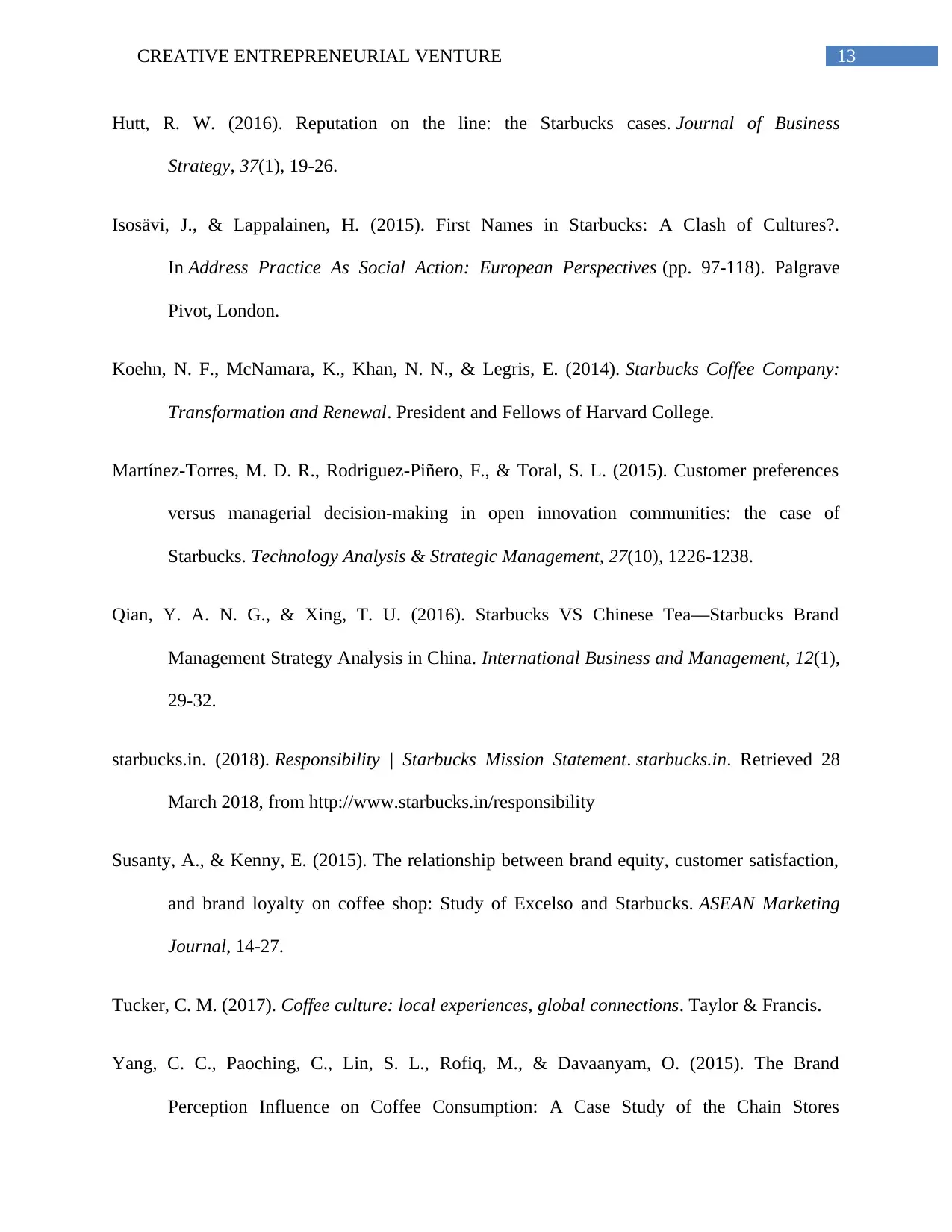
13CREATIVE ENTREPRENEURIAL VENTURE
Hutt, R. W. (2016). Reputation on the line: the Starbucks cases. Journal of Business
Strategy, 37(1), 19-26.
Isosävi, J., & Lappalainen, H. (2015). First Names in Starbucks: A Clash of Cultures?.
In Address Practice As Social Action: European Perspectives (pp. 97-118). Palgrave
Pivot, London.
Koehn, N. F., McNamara, K., Khan, N. N., & Legris, E. (2014). Starbucks Coffee Company:
Transformation and Renewal. President and Fellows of Harvard College.
Martínez-Torres, M. D. R., Rodriguez-Piñero, F., & Toral, S. L. (2015). Customer preferences
versus managerial decision-making in open innovation communities: the case of
Starbucks. Technology Analysis & Strategic Management, 27(10), 1226-1238.
Qian, Y. A. N. G., & Xing, T. U. (2016). Starbucks VS Chinese Tea—Starbucks Brand
Management Strategy Analysis in China. International Business and Management, 12(1),
29-32.
starbucks.in. (2018). Responsibility | Starbucks Mission Statement. starbucks.in. Retrieved 28
March 2018, from http://www.starbucks.in/responsibility
Susanty, A., & Kenny, E. (2015). The relationship between brand equity, customer satisfaction,
and brand loyalty on coffee shop: Study of Excelso and Starbucks. ASEAN Marketing
Journal, 14-27.
Tucker, C. M. (2017). Coffee culture: local experiences, global connections. Taylor & Francis.
Yang, C. C., Paoching, C., Lin, S. L., Rofiq, M., & Davaanyam, O. (2015). The Brand
Perception Influence on Coffee Consumption: A Case Study of the Chain Stores
Hutt, R. W. (2016). Reputation on the line: the Starbucks cases. Journal of Business
Strategy, 37(1), 19-26.
Isosävi, J., & Lappalainen, H. (2015). First Names in Starbucks: A Clash of Cultures?.
In Address Practice As Social Action: European Perspectives (pp. 97-118). Palgrave
Pivot, London.
Koehn, N. F., McNamara, K., Khan, N. N., & Legris, E. (2014). Starbucks Coffee Company:
Transformation and Renewal. President and Fellows of Harvard College.
Martínez-Torres, M. D. R., Rodriguez-Piñero, F., & Toral, S. L. (2015). Customer preferences
versus managerial decision-making in open innovation communities: the case of
Starbucks. Technology Analysis & Strategic Management, 27(10), 1226-1238.
Qian, Y. A. N. G., & Xing, T. U. (2016). Starbucks VS Chinese Tea—Starbucks Brand
Management Strategy Analysis in China. International Business and Management, 12(1),
29-32.
starbucks.in. (2018). Responsibility | Starbucks Mission Statement. starbucks.in. Retrieved 28
March 2018, from http://www.starbucks.in/responsibility
Susanty, A., & Kenny, E. (2015). The relationship between brand equity, customer satisfaction,
and brand loyalty on coffee shop: Study of Excelso and Starbucks. ASEAN Marketing
Journal, 14-27.
Tucker, C. M. (2017). Coffee culture: local experiences, global connections. Taylor & Francis.
Yang, C. C., Paoching, C., Lin, S. L., Rofiq, M., & Davaanyam, O. (2015). The Brand
Perception Influence on Coffee Consumption: A Case Study of the Chain Stores
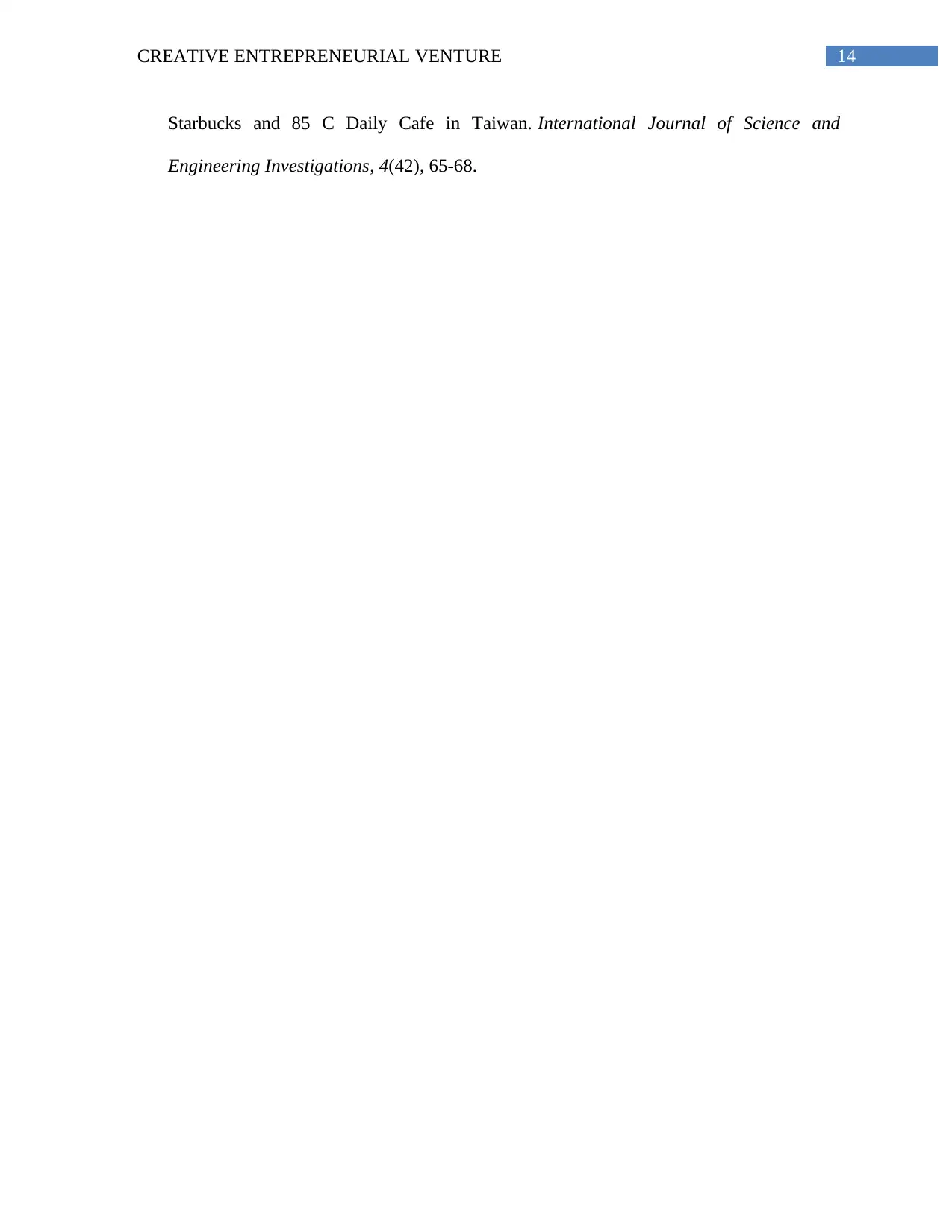
14CREATIVE ENTREPRENEURIAL VENTURE
Starbucks and 85 C Daily Cafe in Taiwan. International Journal of Science and
Engineering Investigations, 4(42), 65-68.
Starbucks and 85 C Daily Cafe in Taiwan. International Journal of Science and
Engineering Investigations, 4(42), 65-68.
1 out of 15
Related Documents
Your All-in-One AI-Powered Toolkit for Academic Success.
+13062052269
info@desklib.com
Available 24*7 on WhatsApp / Email
![[object Object]](/_next/static/media/star-bottom.7253800d.svg)
Unlock your academic potential
© 2024 | Zucol Services PVT LTD | All rights reserved.





